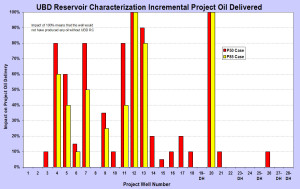Shell reservoir characterization project proves UBD value beyond drilling
By Katie Mazerov, contributing editor

A successful underbalanced drilling (UBD) reservoir characterization campaign in southern Oman provides important lessons for the industry and prods a longer-term view on expanding UBD methodology to gain greater value in challenging oilfields, a Shell engineer suggests. “Most of us agree that there should be wider application of UBD techniques,” Richard S. Medeiros, senior reservoir engineer, Shell International, said in a presentation at the 2013 IADC/SPE Managed Pressure Drilling & Underbalanced Operations Conference & Exhibition in San Antonio on 17-18 April. “The way to broaden the application of UBD is to broaden its reach in terms of what we consider the value that is generated long after the bit stops turning,” he said.
In the case of the Nimr oilfield in Oman, Shell implemented UBD to characterize the reservoir features in order to implement water shut-off and enhance well production. The reservoirs, from different depositional environments, were exhibiting unconformity and uneven flow and were not producing according to reservoir models.
“One thing we can say broadly about managed pressure drilling (MPD) information or UBD reservoir characterization is that it consistently delivers results that are not expected by the petroleum engineering team,” Mr Medeiros said. “For example, areas in the Nimr field that had been identified as tight in our reservoir models actually exhibited some of the highest permeability we had seen in the field. The UBD characterization data also revealed that variations often didn’t correspond with features we could see on reservoir data logs. Logs do a great job of telling us what is going on around the borehole but not a good job telling us where the fluids are going to come from.”
The UBD application in Nimr also presented what Mr Medeiros called a “lucky mistake” that allowed for an opportunity to deploy a swellable elastomer, rather than a solid expandable, to reduce incremental water influx. In October 2003, swellable elastomer joints were installed in a basic barefoot completion, often done in UBD operations where there are no tubulars. Ultimately, water cut was reduced from 90% to 10%.
In the first UBD drilling campaign that was justified solely on reservoir characterization since the Nimr project, as much as 100% of the production in a 28-well project was the result of UBD, be it through sidetracking, over-cutting, under-cutting or plugging the toe. In the first two wells, there was no impact; the third well showed some production gains through sidetracking. “In the fourth well, 80% of its production came from decisions we made while drilling underbalanced,” Mr Medeiros noted.
“It’s important to note that the initial design of this completion was based on UBD data from a year earlier, but we continued to create value from it, and we still are to this day,” he continued. “As of March 2009, the last official report available, more than 250 wells in southern Oman had been completed with this methodology, with incremental oil production of more than 1.3 million bbls on just 80 of those wells.”
Going forward, reservoir characterization by UBD has the potential to deliver a variety of benefits, such as collecting downhole data to reduce uncertainty in influx volumes and more accurately identifying sources of anomalous inflow. “But to expand the application of both MPD and UBD, we need to start by understanding that there is value beyond the UBD operation itself,” Mr Medeiros emphasized. “Service companies need to work more across product lines, and operators need to work across disciplines. We need to get out of our boxes, out of our comfort zones and work across boundaries.”




